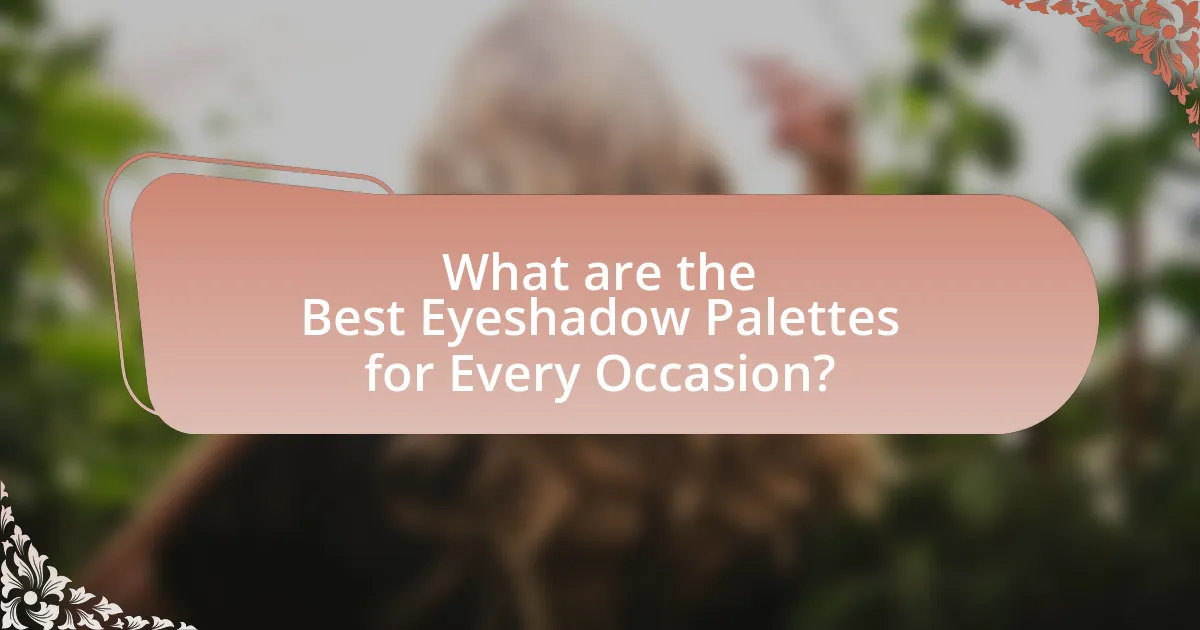The article focuses on the best eyeshadow palettes suitable for various occasions, highlighting popular options such as the Urban Decay Naked Palette, Too Faced Chocolate Bar Palette, and Anastasia Beverly Hills Modern Renaissance Palette. It provides guidance on selecting the right palette based on event formality, time of day, and desired look, while discussing the importance of color schemes and versatility in palettes. Additionally, the article covers application techniques for different occasions, maintenance tips for palettes, and how to choose shades that complement specific skin tones and undertones.

What are the Best Eyeshadow Palettes for Every Occasion?
The best eyeshadow palettes for every occasion include the Urban Decay Naked Palette for versatile day-to-night looks, the Too Faced Chocolate Bar Palette for warm, neutral tones, and the Anastasia Beverly Hills Modern Renaissance Palette for rich, romantic colors. Each of these palettes offers a range of shades suitable for various events, from casual outings to formal gatherings. The Urban Decay Naked Palette features 12 neutral shades that can create both subtle and bold looks, making it ideal for any occasion. The Too Faced Chocolate Bar Palette contains a mix of matte and shimmer finishes, perfect for everyday wear or special events. The Anastasia Beverly Hills Modern Renaissance Palette is known for its highly pigmented colors, allowing for creative and dramatic eye makeup suitable for evening events.
How do you choose the right eyeshadow palette for different events?
To choose the right eyeshadow palette for different events, consider the occasion’s formality, time of day, and desired look. For formal events, opt for neutral or muted tones that enhance elegance, while vibrant colors suit casual gatherings or parties. Daytime events benefit from lighter shades, whereas evening occasions allow for deeper, more dramatic hues. Research indicates that color psychology plays a role in perception; for instance, blue tones can evoke calmness, while reds can convey confidence. Therefore, selecting a palette that aligns with the event’s atmosphere and your personal style ensures a suitable and impactful look.
What factors should you consider when selecting an eyeshadow palette?
When selecting an eyeshadow palette, consider the color range, formula quality, and skin tone compatibility. A diverse color range allows for versatile looks, while high-quality formulas ensure better pigmentation and blendability. Additionally, choosing shades that complement your skin tone enhances the overall appearance. For instance, warm tones suit those with warm undertones, while cool tones are ideal for cooler undertones.
How does the occasion influence your palette choice?
The occasion significantly influences palette choice by dictating the color scheme and intensity of the eyeshadow used. For instance, formal events typically call for neutral or muted tones to create an elegant look, while festive occasions may encourage vibrant colors and bold finishes to enhance the celebratory atmosphere. Research indicates that color psychology plays a role in how individuals perceive and respond to different hues, suggesting that the context of an event can affect both the choice of colors and the overall makeup aesthetic.
What types of eyeshadow palettes are available?
There are several types of eyeshadow palettes available, including matte, shimmer, satin, and metallic palettes. Matte palettes contain eyeshadows with no shine, providing a smooth finish ideal for everyday looks. Shimmer palettes feature eyeshadows with a subtle sheen, perfect for adding dimension to the eyes. Satin palettes offer a soft sheen that is less reflective than shimmer, suitable for a more natural appearance. Metallic palettes contain highly pigmented, reflective shades that create bold, dramatic looks. Each type serves different makeup styles and occasions, catering to various preferences and needs.
What are the differences between matte, shimmer, and glitter eyeshadows?
Matte, shimmer, and glitter eyeshadows differ primarily in their finish and light-reflecting properties. Matte eyeshadows have a flat, non-reflective finish, making them ideal for creating depth and dimension in eye looks. Shimmer eyeshadows contain fine particles that reflect light, providing a subtle glow and enhancing the eye’s brightness. Glitter eyeshadows, on the other hand, feature larger particles that create a bold, sparkling effect, suitable for dramatic looks. These distinctions are crucial for makeup application, as they influence the overall aesthetic and suitability for various occasions.
How do color schemes vary across different palettes?
Color schemes vary across different eyeshadow palettes primarily based on the intended mood, occasion, and color theory principles. For instance, warm palettes typically feature shades like reds, oranges, and yellows, which evoke feelings of warmth and vibrancy, making them suitable for daytime or casual events. In contrast, cool palettes often include blues, greens, and purples, creating a calming effect ideal for evening or formal occasions. Additionally, neutral palettes combine browns, beiges, and taupes, offering versatility for both everyday wear and professional settings. The variation in color schemes is also influenced by trends and seasonal themes, with certain colors gaining popularity during specific times of the year, such as pastels in spring or jewel tones in fall.
Why is versatility important in an eyeshadow palette?
Versatility is important in an eyeshadow palette because it allows users to create a wide range of looks suitable for various occasions. A versatile palette typically includes a mix of matte, shimmer, and neutral shades, enabling users to transition from everyday wear to more dramatic evening looks seamlessly. For instance, palettes that offer both bold colors and subtle tones cater to different preferences and styles, enhancing the overall utility of the product. This adaptability is supported by consumer trends indicating that makeup users prefer products that can serve multiple purposes, thus maximizing their investment in beauty products.
How can a versatile palette be used for both day and night looks?
A versatile palette can be used for both day and night looks by incorporating a range of shades that allow for subtle to bold applications. For daytime, lighter, neutral shades can be applied for a soft, natural appearance, while deeper, more vibrant colors can be layered for evening looks. This adaptability is supported by the fact that many versatile palettes include a mix of matte and shimmer finishes, enabling users to create a variety of effects suitable for different lighting and occasions.
What are some examples of versatile eyeshadow palettes?
Some examples of versatile eyeshadow palettes include the Urban Decay Naked Palette, the Too Faced Chocolate Bar Palette, and the Anastasia Beverly Hills Modern Renaissance Palette. The Urban Decay Naked Palette features a range of neutral shades suitable for both day and night looks, making it a staple for various occasions. The Too Faced Chocolate Bar Palette offers a mix of warm and cool tones, allowing for diverse eye makeup styles. The Anastasia Beverly Hills Modern Renaissance Palette includes rich, blendable colors that can create both soft and bold looks, enhancing its versatility.
What are the best eyeshadow palettes for specific occasions?
The best eyeshadow palettes for specific occasions include the Urban Decay Naked Palette for everyday wear, the Too Faced Chocolate Bar Palette for casual outings, the Huda Beauty Desert Dusk Palette for evening events, and the Anastasia Beverly Hills Modern Renaissance Palette for weddings. Each of these palettes offers a versatile range of colors suitable for their respective occasions, allowing for both subtle and bold looks. For example, the Urban Decay Naked Palette features neutral tones ideal for a natural look, while the Huda Beauty Desert Dusk Palette includes rich, vibrant shades perfect for a glamorous evening.
Which palettes are ideal for everyday wear?
Neutral and versatile palettes are ideal for everyday wear. Palettes that feature a range of nude, taupe, and soft brown shades allow for easy blending and create natural looks suitable for various occasions. For example, the Urban Decay Naked series and the Too Faced Natural Eyes palette are popular choices, as they provide a mix of matte and shimmer finishes that can be used for both subtle daytime looks and more defined evening styles. These palettes are favored for their ability to complement a wide range of skin tones and their ease of application, making them practical for daily use.
What palettes work best for formal events?
Neutral and muted palettes work best for formal events. These palettes typically include shades like taupe, beige, soft browns, and subtle grays, which create an elegant and sophisticated look. For instance, palettes such as the Urban Decay Naked series or the Too Faced Natural Eyes palette are popular choices, as they offer a range of versatile shades that can be blended for a polished appearance. The use of these colors aligns with the formal dress code, ensuring that the makeup complements rather than overshadows the overall attire.
How can you select palettes for seasonal occasions?
To select palettes for seasonal occasions, focus on colors that reflect the mood and themes of each season. For example, spring palettes often feature pastel shades like soft pinks and light greens, while summer palettes may include vibrant colors such as bright oranges and blues. Autumn palettes typically showcase warm tones like deep reds and browns, and winter palettes often incorporate cool shades like icy blues and silvers. This approach aligns with color theory, which suggests that colors can evoke specific emotions and associations tied to seasonal changes.
How do you apply eyeshadow for different occasions?
To apply eyeshadow for different occasions, start by selecting a color palette that suits the event’s formality and mood. For daytime or casual settings, use neutral shades like beige or soft browns, applying a light wash over the eyelid and a slightly darker shade in the crease for depth. For evening or formal events, opt for bolder colors such as deep purples or smoky grays, applying a base color on the lid and blending darker shades into the outer corners for a dramatic effect. Additionally, for special occasions like weddings, consider using shimmer or metallic shades to enhance the eyes, applying them to the center of the lid for added dimension. This approach is supported by makeup artists who emphasize the importance of matching eyeshadow intensity and color to the occasion for a polished look.
What techniques are best for a natural look?
The best techniques for achieving a natural look include using neutral eyeshadow shades, applying a light hand with blending, and opting for matte finishes. Neutral shades like taupes, soft browns, and creams create a subtle base that enhances the eyes without overwhelming them. A light hand during blending ensures that the colors transition smoothly, maintaining a soft appearance. Additionally, matte finishes tend to look more natural compared to shimmery ones, as they mimic the skin’s texture and reflect less light. These techniques are widely recommended by makeup artists for creating a fresh, understated look suitable for various occasions.
How can you create a bold look for a night out?
To create a bold look for a night out, select vibrant eyeshadow colors that stand out, such as deep purples, rich blues, or striking metallics. These shades can enhance your eyes and create a dramatic effect. For instance, using a highly pigmented eyeshadow palette, like the Urban Decay Naked Heat, allows for intense color payoff and long-lasting wear, making it ideal for evening events. Additionally, pairing bold eyeshadow with a defined eyeliner and voluminous mascara can further amplify the look, ensuring that it remains striking throughout the night.
What are some tips for maintaining your eyeshadow palettes?
To maintain your eyeshadow palettes effectively, regularly clean them and store them properly. Cleaning involves using a soft brush or cloth to remove excess powder and prevent cross-contamination between shades. Additionally, storing palettes in a cool, dry place away from direct sunlight helps preserve the integrity of the formulas, as heat and light can degrade the pigments. Keeping palettes tightly closed when not in use prevents dust accumulation and moisture exposure, which can lead to mold growth. These practices ensure the longevity and performance of the eyeshadow palettes.
How can you extend the life of your eyeshadow palettes?
To extend the life of your eyeshadow palettes, store them in a cool, dry place away from direct sunlight and humidity. This prevents the ingredients from breaking down and maintains their pigmentation. Additionally, regularly clean the palette with a gentle disinfectant to remove bacteria and oils that can degrade the product. Research indicates that exposure to heat and moisture can significantly shorten the lifespan of cosmetics, making proper storage essential for longevity.
What are the best practices for cleaning your palettes?
The best practices for cleaning your palettes include using a gentle cleanser, such as isopropyl alcohol or a specialized makeup brush cleaner, to effectively remove pigments and bacteria. First, remove any loose powder by tapping the palette upside down. Then, apply the cleanser to a cotton pad and gently wipe the surface of the palette, ensuring to clean the individual pans without soaking them. After cleaning, allow the palette to air dry completely before closing it to prevent moisture buildup, which can lead to mold. Regular cleaning, ideally after every few uses, helps maintain the integrity of the eyeshadow and ensures hygienic application.
What are the common mistakes to avoid when using eyeshadow palettes?
Common mistakes to avoid when using eyeshadow palettes include applying too much product, neglecting to use a primer, and failing to blend properly. Applying excessive eyeshadow can lead to a heavy, unflattering look, while using a primer enhances color payoff and longevity. Additionally, inadequate blending can result in harsh lines, diminishing the overall aesthetic. These practices are supported by makeup artists who emphasize the importance of moderation, preparation, and technique for achieving a polished appearance.
How can you prevent fallout during application?
To prevent fallout during eyeshadow application, use a combination of techniques such as tapping off excess product, applying a primer, and using a setting spray. Tapping off excess product from the brush minimizes the amount of eyeshadow that can fall onto the cheeks. Applying an eyeshadow primer creates a sticky base that helps the eyeshadow adhere better, reducing the likelihood of fallout. Additionally, using a setting spray after application can lock the eyeshadow in place, further preventing any fallout throughout the day. These methods are widely recommended by makeup artists and are effective in maintaining a clean application.
What should you avoid when blending eyeshadows?
When blending eyeshadows, you should avoid using too much product at once. Overloading the brush can lead to harsh lines and uneven application, making it difficult to achieve a seamless blend. Additionally, using a stiff brush can hinder the blending process, as softer brushes are more effective in diffusing colors smoothly. It is also important to avoid blending too aggressively, as this can cause the eyeshadow to become muddy and lose its vibrancy.
How can you find the perfect eyeshadow palette for your skin tone?
To find the perfect eyeshadow palette for your skin tone, first identify whether your skin tone is warm, cool, or neutral. Warm skin tones typically suit palettes with earthy tones like golds, oranges, and warm browns, while cool skin tones are complemented by shades like blues, purples, and cool greys. Neutral skin tones can wear a mix of both warm and cool shades. According to a study published in the Journal of Cosmetic Science, understanding your undertone is crucial for selecting colors that enhance your natural beauty, as the right shades can brighten your complexion and make your eyes pop.
What shades complement different undertones?
Cool undertones are complemented by shades like blue, purple, and silver, while warm undertones are enhanced by shades such as orange, gold, and warm reds. Neutral undertones can wear a mix of both cool and warm shades, including soft pinks and taupes. This classification is based on color theory, which suggests that colors opposite on the color wheel enhance each other, making them visually appealing when paired with specific undertones.
How can you test colors before purchasing a palette?
To test colors before purchasing a palette, you can use testers available at beauty stores or online retailers that offer virtual try-on tools. Beauty stores often have sample palettes that allow customers to swatch colors directly on their skin, providing a real-time visual of how the shades appear. Additionally, many online retailers now feature augmented reality applications that let users upload their photos and apply virtual eyeshadow colors, helping to visualize how the shades will look on their skin tone. This method is supported by the growing trend of technology in beauty, as studies show that 70% of consumers prefer trying products virtually before buying.


